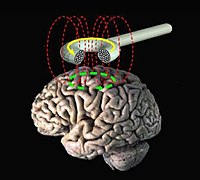
Photo from wikipedia
Anxiety and panic are both elicited by threat and co‐occur clinically. But, at the neural level, anxiety appears to inhibit the generation of panic; and vice versa. Anxiety and panic… Click to show full abstract
Anxiety and panic are both elicited by threat and co‐occur clinically. But, at the neural level, anxiety appears to inhibit the generation of panic; and vice versa. Anxiety and panic are thought to engage more anterior (a) and mid‐posterior (m) parts of the periaqueductal gray (PAG), respectively. Anxiety also engages the hippocampus and medial prefrontal cortex. Here, we tested if mPAG but not aPAG stimulation would suppress prefrontal and hippocampal theta rhythm as do anxiolytic drugs. Twelve male rats with implanted electrodes were stimulated alternately (30 s interval) in the left PAG or right reticular formation (reticularis pontis oralis [RPO]—as a positive control) with recording in the left prelimbic cortex and left and right hippocampus. PAG stimulation was set to produce freezing and RPO to produce 7–8 Hz theta rhythm before tests lasting 10 min on each of 5 days. mPAG stimulation decreased, and aPAG increased, theta power at all sites during elicited freezing. mPAG, but not aPAG, stimulation decreased prefrontal theta frequency. Stimulation did not substantially change circuit dynamics (pairwise phase consistency and partial directed coherence). Together with previous reports, our data suggest that panic‐ and anxiety‐control systems are mutually inhibitory, and neural separation of anxiety and panic extends down to the aPAG and mPAG, respectively. Our findings are consistent with recent proposals that fear and anxiety are controlled by parallel neural hierarchies extending from PAG to the prefrontal cortex.
Journal Title: Hippocampus
Year Published: 2022
Link to full text (if available)
Share on Social Media: Sign Up to like & get
recommendations!